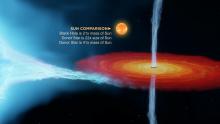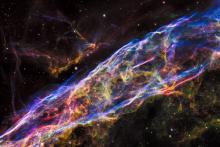Listen to today's episode of StarDate on the web the same day it airs in high-quality streaming audio without any extra ads or announcements. Choose a $8 one-month pass, or listen every day for a year for just $30.
You are here
Vanishing Planets
A star in Cygnus, the swan, is entering the final stages of life, so it’s starting to puff up like a giant balloon. And that’s trouble for two of its planets. Over the next couple of hundred million years, they’ll be roasted and then engulfed by the dying star.
The system is known as Kepler 56. It’s about halfway between bright Vega, which is high in the east at nightfall, and slightly fainter Deneb, the tail of the swan, to the lower left of Vega.
The star is younger than the Sun, but it’s also heavier, so it’s quickly converted the original hydrogen fuel in its core to helium — a process that will continue in the Sun for several billion years. Today, the core of Kepler 56 is quiet, with nuclear reactions taking place only in a thin shell around the core.
In response to that change, the outer layers are puffing outward, toward two planets. Both worlds are much closer to Kepler 56 than Mercury, the innermost planet in our own solar system, is to the Sun. And both are quite large and puffy — similar to the giants of the solar system.
As Kepler 56 continues to evolve, its outer layers will expand even more. As the star’s surface approaches the planets, their atmospheres will vaporize and stream off into space, leaving only their dense cores. Eventually, those bare chunks of rock and metal will fall into Kepler 56 — and the two planets will vanish from the universe.
Script by Damond Benningfield





